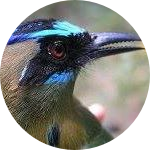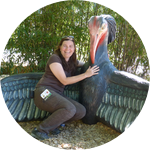About This Project
The purpose of this study is to create a standardized framework for evaluation of ulcerative dermatitis in Waldrapp ibis, with the ultimate goal of discovering the root cause of this condition in captive populations. This will be accomplished using a structured, multi-factorial approach that includes thorough analysis of skin biopsies, serology and husbandry. This research is supported by the Waldrapp Ibis SSP.
Ask the Scientists
Join The DiscussionWhat is the context of this research?
The guidelines for the conservation and reintroduction of Waldrapp were established by the International Advisory Group for the Northern Bald Ibis. This group recommends that wild populations not be augmented by zoo-bred ibis. This decision is based on the prevalence of ulcerative dermatitis in zoo birds with no clear cause or treatment. As these birds are critically endangered, there is a fear that an unknown disease process could be introduced into the wild.
The hope behind this project is that by standardizing testing of the birds and establishing a method of quantifying the skin lesions, the true prevalence of ulcerative dermatitis can be established. This project is the first study of it's kind in this species.
What is the significance of this project?
The Northern Bald Ibis was once widespread across the Middle East, northern Africa, southern and central Europe. Currently, there are believed to be fewer than 500 wild birds in Morocco and fewer than 10 in Syria where is was rediscovered in 2002. Recent reintroduction programs have been instituted internationally with breeding sites in Turkey, Austria, Spain and northern Morocco. These programs helped downlist this bird from Critically Endangered to Endangered on the IUCN Red List in 2018. However, there is concern that genetic bottlenecking may occur without the option of maintaining genetic diversity by moving zoo bred birds into reintroduction programs. Especially since many of thee breeding sites are in war torn areas.
What are the goals of the project?
Within the year, I hope to create a standardized grading scale to assess extent and severity of ulcerative dermatitis to implement across the SSP. This is done by using diagrams and photos to quantify dermatitis. Will use percent of body affected along with depth and size of ulcerations to set the grades. Data from husbandry surveys, dermatitis grading forms, bloodwork, and skin biopsies will also be analyzed to determine ulcerative dermatitis etiology. The bloodwork will potentially indicate any nutritional deficencies that may predispose these birds to skin disease. The biopsies will better characterize the extent of skin disease on a cellular level. With this information, we hope to improve the health of this species.
Budget
This proposal seeks to address the issue of widespread ulcerative dermatitis in the North American Waldrapp ibis population by asking institutions to provide two full-thickness skin biopsies from each bird to a single pathology service. Each facility will be asked to provide blood samples from each bird to a single serology service. To eliminate variances in collection, storage, and shipping methods, protocols for each procedure have been established and will be distributed. Serum will undergo vitamin, mineral, and trace element analysis to determine any nutritional cause for this skin disease.
Upon collation and analysis of all results, emerging patterns hopefully will be detected. The scope of this project is quite vast. There are 162 birds in the North American population. With this proposed budget, we will only be able to perform this initial testing on 25 birds, and we are continuing to search for additional funding sources.
Endorsed by
 Project Timeline
Project Timeline
May 6: Dallas Zoo send requests to Initial Waldrapp ibis-holding institutions
May - August: Partner institutions send all serum samples and biopsies to pathology and serology services, and return all husbandry surveys and severity grading forms to Dallas Zoo team
September: Dallas Zoo team receives results
October: Dallas Zoo team collates and analyzes results from serum analysis, bloodwork, and husbandry surveys
December 31, 2019: Publication in academic journal
Feb 06, 2019
Project Launched
Mar 01, 2019
Establish a grading scale for ulcerative dermatitis severity and create a husbandry survey for completion by participating institutions.
Apr 03, 2019
Build out visual element of grading scale using pictures of affected birds received from participating institutions.
Nov 01, 2019
Disseminate any findings via the SSP
Nov 01, 2019
Collate results of bloodwork, skin biopsies, and survey responses. Analyze data, identifying any emerging patterns that may indicate cause of ulcerative dermatitis.
Meet the Team
Jan Raines
A graduate of the LSU-School of Veterinary Medicine (Geaux Tigers!!) and of Tulane University (Roll Wave!).
I have been a practicing zoo veterinarian for 21 years, 14 of those at the Dallas Zoo. The entire veterinary team has been working closely with our Bird department with this species since 2006. I have been to multiple zoos in Europe that hold this bird and they truly love and adore this species.
Hopefully, this project will be funded and we will be well on our way to ruling out a cause!
Additional Information
The genus name, Geroticus, is derived from the ancient Greek meaning "old man" referring to its bald head. Eremita is Latin for "hermit" from the Greek meaning "desert" and refers to its arid habitat. The alternative common name for the Northern Bald Ibis is Waldrapp Ibis. Waldrapp is German for "forest crow".
Project Backers
- 9Backers
- 7%Funded
- $329Total Donations
- $36.56Average Donation

